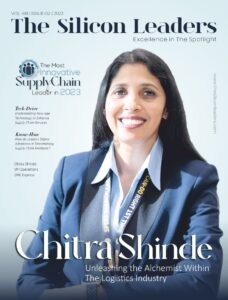Urban planning today is greatly influenced by the need for sustainability and technological integration. Cities are becoming increasingly dense, necessitating innovative approaches to ensure they remain liveable and attractive. Smart design solutions are essential to creating efficient and adaptable urban environments. Emerging modes of personal mobility, such as e-bikes and scooters, are reshaping the way people interact with their cities, offering new autonomy and alternatives to traditional transportation systems. The potential of autonomous vehicles and aerial ridesharing promises further transformation, presenting opportunities for urban planning to enhance accessibility and improve the overall quality of life.
Nayan Parekh, Principal and Global Work Sector Leader, emphasises the centrality of human experience in the future of design. As an architect and social scientist, Nayan is inspired by the potential of smart cities to revolutionise urban living by improving efficiency, sustainability, and responsiveness to individual needs. Her focus is on creating cities that enhance human experiences and nurture connections among people, communities, organisations, and families. She sees the development of smart cities as a critical solution to the challenges of rapid urbanisation and climate change, offering ways to manage growing populations while building healthier, more resilient environments.
At Gensler, Nayan and her team integrate technology with sustainable design to develop smart urban spaces that prioritise human-centred solutions. The firm’s work on the Gensler Cities Climate Challenge (GC3) reflects a commitment to achieving carbon neutrality by 2030 through improved energy efficiency and the use of sustainable materials. Gensler’s philosophy involves close collaboration with clients to create designs that boost connectivity, encourage community engagement, and enhance the overall quality of life. Their comprehensive approach ensures that each project supports the goal of reducing carbon footprints and promoting sustainable urban development.
Let’s explore Nayan’s innovative leadership in urban planning:
Revolutionising Power Generation
According to Nayan, urban planning is primarily about the design of systems. At the core of what makes dense urban environments authentic, desirable, and attractive is a network of forces that create unpredictability, uncertainty and diversity.
As designers and architects at Gensler, developing smart cities is all about blending technology with sustainable design to make urban spaces that are efficient, liveable, and ready for the future. For example, emerging modes of personal mobility, such as e-bikes and scooters, have already created new autonomy of movement for many people, re-shaped individual spatial relationships with cities, and offered alternatives to overcrowded public transportation systems.
With next-generation transportation options like autonomous vehicles and aerial ridesharing on the horizon, urban planning is still at the onset of this paradigm shift, which will present wide-ranging opportunities. With smart design solutions, autonomous mobility could become a means of accessibility for all.
Gensler’s philosophy is to work closely with clients to understand their vision and needs and respond with a design that boosts connectivity, encourages community engagement, and enhances the overall quality of life. Everything Gensler does is guided by its mission: to create a better world through the power of design.
Human-centred Design in the Age of Smart Cities
Nayan believes that the human experience is central to the future of design. In an era marked by rapid technological advancements, demographic shifts, global volatility, and climate change, people remain constants. This period of profound change compels her to rethink and reinvent how individuals experience their lives and the spaces they inhabit.
As an architect and social scientist, Nayan enjoys studying and designing the interplay between people and place. The potential of smart cities to revolutionise urban living by improving efficiency, sustainability, and responsiveness to individual needs has truly inspired her and her team at Gensler. Their focus is on creating cities that enhance human experiences, fostering connections among people, communities, organisations, families, and friends.
Additionally, the swift pace of urbanisation and the escalating effects of climate change underscores the urgent need for sustainable urban development. Nayan sees smart cities as a vital solution to these challenges, offering a way to manage growing populations while also building healthier, more resilient environments. This goes beyond just technologically advanced solutions and extends to deeply human-centred solutions, ensuring that the technology they incorporate genuinely enhances the quality of life for everyone.
Smart solutions could expand the possibility of alternative uses for public rights-of-way and support more flexible use patterns of streets and roadways that account for about 30% of the public space in most cities. Pavements, for example, could be expanded outside of rush hours to be made accessible for neighbourhood activities or generally yield to the increased demand for space in times of social distancing.
Integrating Sustainability from the Outset
At Gensler, environmental stewardship is a core priority, as reflected in the Gensler Cities Climate Challenge (GC3). This initiative underscores the commitment to achieving carbon neutrality, with the goal of making every building in the portfolio net-zero carbon by 2030. The strategy centres on two main areas: reducing operational carbon through improved energy efficiency and increased use of onsite renewable energy, minimising embodied carbon by selecting low-impact materials, and prioritising reuse over new construction.
The depth and breadth of the shared pandemic experience globally created an opportunity to reposition the mindset towards sustainable behaviour going forward. While a shutdown and the resulting economic crisis were not a good way to achieve cleaner air, cleaner water, and a greener world, here are a few things anticipated that are reflective of safer, sustainable approaches within the industry:
Utilities: Microgrids are a way of providing highly targeted, flexible, and efficient utility services to districts or large-scale developments that can both connect and disconnect from the traditional grid and function independently as physical or economic conditions might warrant.
Modular construction: Fabricating and assembling building components offsite in contained warehouses could prove to be a healthier alternative to traditional construction and a faster way to construct and deliver facilities quickly to address the crisis.
Breathing buildings: The introduction of outside air, including façade systems that allow high-rise buildings to “breathe,” will become the next generation of living buildings. The introduction of fresh, clean air not only helps maintain healthier environments but can also help dilute the human-to-human passage of airborne elements. Smaller packages and horizontal distribution ductwork will emerge to isolate zones when necessary.
Working from Home: While the jury is still out on the global work-from-home experiment that everyone finds themselves in, initial findings are pointing to a more hybrid model for the future of work—part home and part office. This will change the composition of how office spaces are designed and used and force the repositioning of single-use buildings within the CBD. It will likely also impact the design of residential products in the future.
Gensler adopts a comprehensive approach to sustainability, integrating environmental considerations from the very beginning and ensuring that each design element supports the goal of reducing carbon footprints. This includes optimising energy usage, implementing sustainable construction practices, and choosing materials with minimal environmental impact. Advanced design technology tools are also utilised to incorporate resilience and sustainability into projects, allowing real-time assessment and enhancement of environmental performance.
Promoting Sustainable Development
Gensler developed a suite of technologies essential for advancing smart cities. The firm’s proprietary technology suite, NFORM, is a data-informed design tool that supports sustainable solutions for architecture, interiors, and urban design. It enables Gensler to predict, simulate, evaluate, and optimise various design elements, from floor layouts to carbon footprints, thus enabling confident design decisions.
The latest addition, gPlanet, is a sustainability-focused workflow and software solution that emphasises resilience analysis, allowing real-time design resilience throughout all project stages. Together, these tools integrate advanced technologies, sustainability, and data-driven insights into Gensler’s projects, creating efficient, adaptive, and environmentally friendly urban spaces.
By adopting technology and data, Gensler enhances sustainable design and urban resilience by precisely optimising and predicting design elements, helping the company create more efficient urban spaces. Gensler incorporates insights from stakeholders, including the government, private sector, and academia, and integrates advanced technological solutions to enable buildings to adapt autonomously to environmental changes, optimise resource utilisation, and minimise waste.
In the long term, these tools cultivate sustainable development by promoting innovative materials and construction techniques, creating buildings that are sustainable, durable, and efficient throughout their lifecycle.
Collaborative Approach to Smart City Projects
Collaboration is at the heart of Gensler’s approach to smart city projects. The firm believes that the success of these initiatives hinges on the strength of its partnerships with government agencies, the private sector, and academic institutions. By working closely with these stakeholders, Gensler ensures a comprehensive and holistic approach to urban development that addresses multiple facets of city planning and design.
Gensler’s collaborations involve active participation in public-private partnerships, combining resources and expertise to tackle urban challenges. The company also engages in continuous knowledge exchange with academic experts, staying abreast of the latest research and innovations in the field.
For example, Gensler recently partnered with Singapore’s Building and Construction Authority to develop a podcast series that explores the impact of technology on the built environment. This initiative not only highlights Gensler’s commitment to thought leadership but also fosters a broader understanding of smart city concepts among the public and industry professionals.
By nurturing strong relationships with all stakeholders, Gensler creates synergies that drive the successful implementation of smart city solutions. These partnerships enable the company to pool collective knowledge, share best practices, and innovate effectively, ensuring that its projects are sustainable, resilient, and aligned with the needs and goals of the communities served.
The Future of Mobility
According to the Gensler Design Forecast 2024 report, eight key trends are shaping the future of the built industry. A prominent trend is the development of multifunctional 20-minute neighbourhoods. These are designed to offer all essential services and amenities within a 20-minute walk or bike ride from residents’ homes. This approach tackles crucial challenges such as advancing thriving workplaces, providing affordable housing, and ensuring accessible transportation.
To achieve this, Nayan expects enhanced mobility solutions to revolutionise urban transportation. Innovations such as autonomous vehicles, smart traffic management systems, and integrated public transit networks are set to reduce congestion, lower emissions, and offer more efficient and convenient travel options. These advancements will make urban mobility more sustainable and user-friendly.
Another major trend that Gensler has identified is the integration of advanced technologies like AI, IoT, and big data analytics. These technologies will enable real-time monitoring and management of city services, improving efficiency and responsiveness.
Nayan believes data-driven decision-making will become vital for smart cities. It will allow for better predictions, trend analysis, and optimization of urban systems, ensuring that urban planning and policy decisions are based on accurate and comprehensive data.


